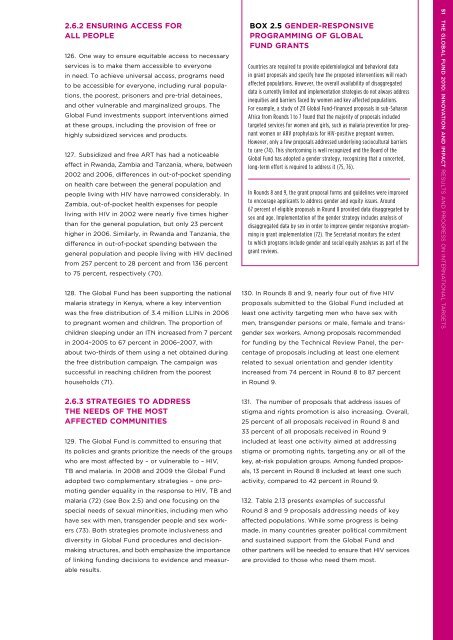Global Fund: Progress Report 2010 - unaids
Global Fund: Progress Report 2010 - unaids
Global Fund: Progress Report 2010 - unaids
You also want an ePaper? Increase the reach of your titles
YUMPU automatically turns print PDFs into web optimized ePapers that Google loves.
2.6.2 Ensuring access for<br />
all people<br />
126. One way to ensure equitable access to necessary<br />
services is to make them accessible to everyone<br />
in need. To achieve universal access, programs need<br />
to be accessible for everyone, including rural populations,<br />
the poorest, prisoners and pre-trial detainees,<br />
and other vulnerable and marginalized groups. The<br />
<strong>Global</strong> <strong>Fund</strong> investments support interventions aimed<br />
at these groups, including the provision of free or<br />
highly subsidized services and products.<br />
127. Subsidized and free ART has had a noticeable<br />
effect in Rwanda, Zambia and Tanzania, where, between<br />
2002 and 2006, differences in out-of-pocket spending<br />
on health care between the general population and<br />
people living with HIV have narrowed considerably. In<br />
Zambia, out-of-pocket health expenses for people<br />
living with HIV in 2002 were nearly five times higher<br />
than for the general population, but only 23 percent<br />
higher in 2006. Similarly, in Rwanda and Tanzania, the<br />
difference in out-of-pocket spending between the<br />
general population and people living with HIV declined<br />
from 257 percent to 28 percent and from 136 percent<br />
to 75 percent, respectively (70).<br />
128. The <strong>Global</strong> <strong>Fund</strong> has been supporting the national<br />
malaria strategy in Kenya, where a key intervention<br />
was the free distribution of 3.4 million LLINs in 2006<br />
to pregnant women and children. The proportion of<br />
children sleeping under an ITN increased from 7 percent<br />
in 2004–2005 to 67 percent in 2006–2007, with<br />
about two-thirds of them using a net obtained during<br />
the free distribution campaign. The campaign was<br />
successful in reaching children from the poorest<br />
households (71).<br />
BOX 2.5 GENder-rESPONSIVE<br />
prOGrammING OF GLOBAL<br />
FUNd grANTS<br />
Countries are required to provide epidemiological and behavioral data<br />
in grant proposals and specify how the proposed interventions will reach<br />
affected populations. However, the overall availability of disaggregated<br />
data is currently limited and implementation strategies do not always address<br />
inequities and barriers faced by women and key affected populations.<br />
For example, a study of 211 <strong>Global</strong> <strong>Fund</strong>-financed proposals in sub-Saharan<br />
Africa from Rounds 1 to 7 found that the majority of proposals included<br />
targeted services for women and girls, such as malaria prevention for pregnant<br />
women or ARV prophylaxis for HIV-positive pregnant women.<br />
However, only a few proposals addressed underlying sociocultural barriers<br />
to care (74). This shortcoming is well recognized and the Board of the<br />
<strong>Global</strong> <strong>Fund</strong> has adopted a gender strategy, recognizing that a concerted,<br />
long-term effort is required to address it (75, 76).<br />
In Rounds 8 and 9, the grant proposal forms and guidelines were improved<br />
to encourage applicants to address gender and equity issues. Around<br />
67 percent of eligible proposals in Round 8 provided data disaggregated by<br />
sex and age. Implementation of the gender strategy includes analysis of<br />
disaggregated data by sex in order to improve gender responsive programming<br />
in grant implementation (72). The Secretariat monitors the extent<br />
to which programs include gender and social equity analyses as part of the<br />
grant reviews.<br />
130. In Rounds 8 and 9, nearly four out of five HIV<br />
proposals submitted to the <strong>Global</strong> <strong>Fund</strong> included at<br />
least one activity targeting men who have sex with<br />
men, transgender persons or male, female and transgender<br />
sex workers. Among proposals recommended<br />
for funding by the Technical Review Panel, the percentage<br />
of proposals including at least one element<br />
related to sexual orientation and gender identity<br />
increased from 74 percent in Round 8 to 87 percent<br />
in Round 9.<br />
51 THE GLOBAL FUND <strong>2010</strong>: INNOVATION AND IMPACT results aND progress ON internatiONal targets<br />
2.6.3 Strategies to address<br />
the needs of the most<br />
affected communities<br />
129. The <strong>Global</strong> <strong>Fund</strong> is committed to ensuring that<br />
its policies and grants prioritize the needs of the groups<br />
who are most affected by – or vulnerable to – HIV,<br />
TB and malaria. In 2008 and 2009 the <strong>Global</strong> <strong>Fund</strong><br />
adopted two complementary strategies – one promoting<br />
gender equality in the response to HIV, TB and<br />
malaria (72) (see Box 2.5) and one focusing on the<br />
special needs of sexual minorities, including men who<br />
have sex with men, transgender people and sex workers<br />
(73). Both strategies promote inclusiveness and<br />
diversity in <strong>Global</strong> <strong>Fund</strong> procedures and decisionmaking<br />
structures, and both emphasize the importance<br />
of linking funding decisions to evidence and measurable<br />
results.<br />
131. The number of proposals that address issues of<br />
stigma and rights promotion is also increasing. Overall,<br />
25 percent of all proposals received in Round 8 and<br />
33 percent of all proposals received in Round 9<br />
included at least one activity aimed at addressing<br />
stigma or promoting rights, targeting any or all of the<br />
key, at-risk population groups. Among funded proposals,<br />
13 percent in Round 8 included at least one such<br />
activity, compared to 42 percent in Round 9.<br />
132. Table 2.13 presents examples of successful<br />
Round 8 and 9 proposals addressing needs of key<br />
affected populations. While some progress is being<br />
made, in many countries greater political commitment<br />
and sustained support from the <strong>Global</strong> <strong>Fund</strong> and<br />
other partners will be needed to ensure that HIV services<br />
are provided to those who need them most.

















